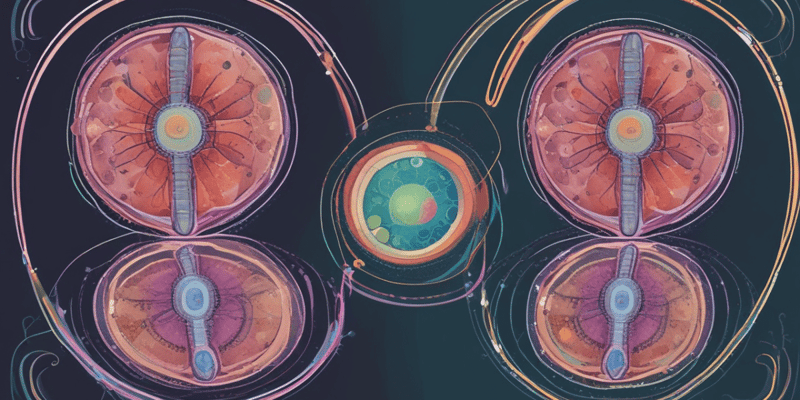25 Questions
What is the main purpose of mitotic cell division?
To repair damaged cells
Which term did W. Flemming use to describe the long thread-like chromosomes observed during mitosis?
Mito
In which type of cells does mitotic cell division occur frequently throughout life?
Intestinal epithelial cells
What is the significance of mitotic cell division during development?
To produce new individuals
During which stage of the cell cycle do the chromosomes condense, the nuclear envelope breaks down, and the cytoskeleton reorganizes to form a mitotic spindle?
Prophase
What is the main goal of mitosis?
To produce two genetically identical daughter cells from a diploid parent cell
Which phase of mitosis follows prophase and is characterized by the alignment of chromosomes in the center of the spindle?
Metaphase
What holds two sister chromatids together during metaphase?
Centromere
What is triggered by the kinetochore's division during mitosis?
Anaphase
Which phase of mitosis follows anaphase and is characterized by the decondensation of chromosomes and the reforming of the nucleus?
Telophase
When does cytokinesis begin and complete during mitosis?
Begins in anaphase and completes in telophase
What structure forms during prophase, with centrosomes separating and moving to opposite sides of the nucleus?
Mitotic spindle
What are chromosomes made up of?
Sister chromatids
What happens to sister chromatids during anaphase?
They separate and move to opposite poles
What happens during interphase?
The cell grows and duplicates its mass
What is the purpose of mitosis in eukaryotic cells?
To ensure genetic continuity
Which protein complex is responsible for inducing chromatin condensation to form metaphase chromosomes?
Condensins
What is the role of cohesins in maintaining the linkage between sister chromatids following replication?
Hold sister chromatids together
What initiates the development of the mitotic spindle at prophase?
Centrosomes
Which class of microtubules is attached to kinetochores of the chromosomes?
Kinetochorial microtubules
What marks the last stage of the cell cycle?
Cytokinesis
What is responsible for dividing the cytoplasm in higher plant cells?
Cell plate
What protein complex binds to DNA in S phase and maintains linkage between sister chromatids?
Cohesins
Which protein complex induces chromosome condensation to form metaphase chromosomes?
Condensins
What happens at telophase in higher plant cells?
Cell plate expands outward
Study Notes
- The cell cycle consists of two major stages: interphase and mitosis.
- Interphase is the longest phase, where cells require more time to grow and duplicate their mass. Mitosis lasts only one hour.
- Mitosis aims to produce two genetically identical daughter cells from a diploid parent cell.
- Mitosis consists of six stages: prophase, prometaphase, metaphase, anaphase, telophase, and cytokinesis.
- During mitosis, the chromosomes condense, the nuclear envelope breaks down, and the cytoskeleton reorganizes to form a mitotic spindle.
- Sister chromatids then separate and move to opposite poles, resulting in the formation of two identical nuclei, and the cytoplasm divides.
- Mitosis occurs in all eukaryotic cells to ensure genetic continuity.
- Chromosomes are long, thread-like structures made up of two sister chromatids that attach firmly together during prophase.
- The nucleolus disappears, and the nuclear envelope begins to break down, marking the start of prophase.
- The mitotic spindle forms during prophase, with centrosomes separating and moving to opposite sides of the nucleus.
- During prometaphase, the chromosomes become thicker and shorter as they condense further, and the microtubules of the mitotic spindle attach to the kinetochores of the chromosomes.
- Sister chromatids move back and forth along the metaphase plate until they align in the center of the spindle during metaphase.
- Two sister chromatids are held together only at the centromere during metaphase.
- Anaphase is triggered by the kinetochore's division, causing the sister chromatids to separate and move to opposite poles of the spindle.
- Telophase follows anaphase, where the chromosomes decondense, and the nucleus reforms.
- Cytokinesis begins during anaphase and is complete by the end of telophase, dividing the cytoplasm and giving rise to two daughter cells.
- Mitosis is a critical process in ensuring genetic continuity and the production of genetically identical daughter cells.
Test your knowledge about the two main types of cell division - mitosis and meiosis. Learn about the differences in the division of somatic cells and production of germ cells, and understand how living cells come from other living cells through this essential biological process.
Make Your Own Quizzes and Flashcards
Convert your notes into interactive study material.
Get started for free



